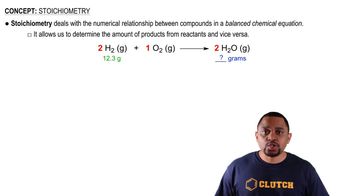(b) Menthol, the substance we can smell in mentholated cough drops, is composed of C, H, and O. A 0.1005-g sample of menthol is combusted, producing 0.2829 g of CO2 and 0.1159 g of H2O. What is the empirical formula for menthol? If menthol has a molar mass of 156 g/mol, what is its molecular formula?
Ch.3 - Chemical Reactions and Reaction Stoichiometry
Chapter 3, Problem 7d2
Nitrogen 1N22 and hydrogen 1H22 react to form ammonia 1NH32. Consider the mixture of N2 and H2 shown in the accompanying diagram. The blue spheres represent N, and the white ones represent H. (d) If so, how many of which type are left over?
How many N2 molecules are left over?
 Verified step by step guidance
Verified step by step guidance1
Identify the balanced chemical equation for the reaction: \( N_2 + 3H_2 \rightarrow 2NH_3 \).
Determine the initial number of \( N_2 \) and \( H_2 \) molecules from the diagram.
Calculate the limiting reactant by comparing the mole ratio of \( N_2 \) to \( H_2 \) with the stoichiometric ratio from the balanced equation.
Use the limiting reactant to determine how many \( N_2 \) molecules are consumed in the reaction.
Subtract the number of \( N_2 \) molecules consumed from the initial number to find how many \( N_2 \) molecules are left over.

Verified Solution
Video duration:
6mWas this helpful?
Key Concepts
Here are the essential concepts you must grasp in order to answer the question correctly.
Stoichiometry
Stoichiometry is the branch of chemistry that deals with the quantitative relationships between the reactants and products in a chemical reaction. It allows us to calculate how much of each substance is consumed or produced based on balanced chemical equations. In this case, understanding the stoichiometric ratios of nitrogen and hydrogen in the formation of ammonia is essential to determine how many molecules remain after the reaction.
Recommended video:
Guided course

Stoichiometry Concept
Molecular Representation
Molecular representation involves visualizing molecules using symbols or models to understand their composition and structure. In the given question, nitrogen (N2) is represented by blue spheres and hydrogen (H2) by white spheres. This representation helps in identifying how many molecules of each reactant are present and how they interact during the reaction to form ammonia (NH3).
Recommended video:
Guided course

Molecular Polarity
Limiting Reactant
The limiting reactant is the substance that is completely consumed first in a chemical reaction, thus determining the maximum amount of product that can be formed. Identifying the limiting reactant is crucial for calculating how many molecules of the other reactants remain after the reaction. In this scenario, knowing which reactant (N2 or H2) limits the formation of ammonia will help answer how many N2 molecules are left over.
Recommended video:
Guided course

Limiting Reagent Concept
Related Practice
Textbook Question
2102
views
Textbook Question
When a mixture of 10.0 g of acetylene 1C2H22 and 10.0 g of oxygen 1O22 is ignited, the resulting combustion reaction produces CO2 and H2O. (c) How many grams of CO2 are present after the reaction is complete?
394
views
Textbook Question
When a mixture of 10.0 g of acetylene 1C2H22 and 10.0 g of oxygen 1O22 is ignited, the resulting combustion reaction produces CO2 and H2O. (c) How many grams of C2H2 are present after the reaction is complete?
799
views
Textbook Question
Nitrogen 1N22 and hydrogen 1H22 react to form ammonia 1NH32. Consider the mixture of N2 and H2 shown in the accompanying diagram. The blue spheres represent N, and the white ones represent H. (d) Are any reactant molecules left over, based on the diagram?
440
views
